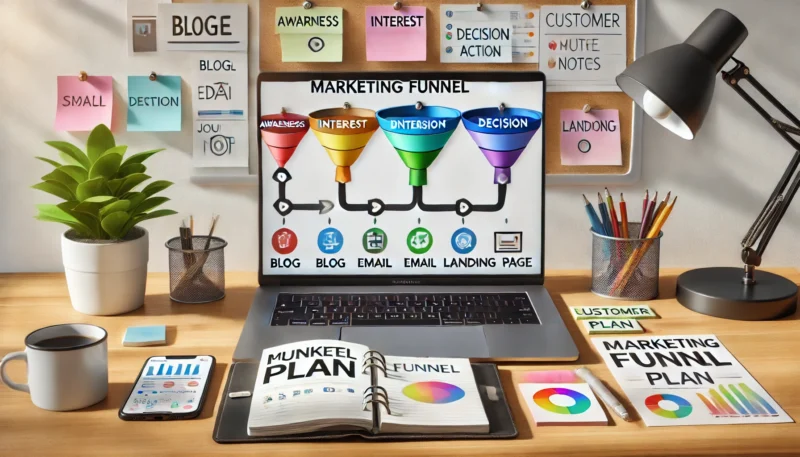If you’ve ever heard the term “marketing funnel” and felt a little lost — you’re not alone. While it sounds technical, the idea is simple: a marketing funnel maps the journey your audience takes from stranger to customer.
Understanding and using a funnel can transform how you attract leads, nurture interest, and convert traffic into real revenue.
In this guide, you’ll learn what a marketing funnel is, why it matters, and how to use it to grow your online business.
What Is a Marketing Funnel?
A marketing funnel is a visual model of how people move from learning about your business to becoming a paying customer.
It’s called a “funnel” because many people enter the top, but fewer reach the bottom — like this:
1. Awareness 👀
2. Interest 🤔
3. Decision ✅
4. Action 💸
Each stage has different goals, messages, and tools.
The 4 Main Stages of a Marketing Funnel
1. Awareness Stage (Top of Funnel / TOFU)
Goal: Help people discover your brand.
People at this stage may not know they have a problem — or that a solution like yours exists.
Strategies:
-
Blog posts (SEO-optimized)
-
Social media content
-
Short-form videos (Reels, TikTok)
-
Podcast episodes
-
YouTube tutorials
-
Lead magnets (eBooks, checklists)
✅ Don’t sell yet. Just provide value and visibility.
2. Interest Stage (Middle of Funnel / MOFU)
Goal: Build trust and position your offer.
Now they know you exist. They’re curious — but not convinced yet.
Strategies:
-
Email sequences
-
Case studies and testimonials
-
Retargeting ads
-
Free trials or demos
-
Webinars and deep-dive videos
-
Quizzes or assessments
✅ Focus on solving problems and proving credibility.
3. Decision Stage (Bottom of Funnel / BOFU)
Goal: Convert leads into customers.
At this point, they’re comparing options or waiting for a final nudge.
Strategies:
-
Limited-time offers
-
Personalized outreach
-
Product comparison pages
-
Pricing breakdowns
-
Testimonials and reviews
-
Retargeting with urgency (“Only 2 seats left”)
✅ Make the next step crystal clear and reduce friction.
4. Action & Retention (Post-Purchase)
Goal: Delight, retain, and upsell.
The funnel doesn’t end with the sale — now is the time to deliver value and turn buyers into loyal fans.
Strategies:
-
Welcome emails
-
How-to guides for new users
-
Loyalty or referral programs
-
Product upsells or cross-sells
-
Customer support automations
-
Feedback and reviews
✅ A happy customer is your best marketer.
Why Marketing Funnels Matter
-
Help you organize your strategy
-
Improve conversion rates by stage
-
Lower your customer acquisition cost (CAC)
-
Build trust over time
-
Give you better insight into what’s working
Without a funnel, your marketing might feel random. With one, every action has a purpose.
Simple Funnel Example: Selling a Course
-
Awareness – Blog post: “How to Start Freelancing”
-
Interest – Lead magnet: “Freelancer Starter Toolkit”
-
Decision – Email: “How Alex Landed His First 5 Clients in 30 Days”
-
Action – Retargeting ad: “Enroll Now – Bonus Module Ends Tonight”
-
Post-Sale – Onboarding email + invite to private Slack group
Tools to Build Your Funnel
-
Landing Pages: Unbounce, ClickFunnels, Carrd, Leadpages
-
Email Marketing: Mailchimp, ConvertKit, Klaviyo
-
Ad Platforms: Meta Ads, Google Ads, TikTok Ads
-
Automation: Zapier, ActiveCampaign, MailerLite
-
Analytics: GA4, Hotjar, Meta Pixel
✅ Use automation to move leads from one stage to the next.
Common Funnel Mistakes to Avoid
🚫 Pushing for the sale too soon
🚫 Using the same message for everyone
🚫 Ignoring email follow-up
🚫 Not tracking funnel metrics
🚫 Forgetting post-purchase nurturing
Final Thoughts: Funnels Make Marketing Make Sense
Think of your marketing funnel as a map. Instead of shouting into the void, you’re guiding your audience through a clear, helpful journey — step by step.
Start simple. Focus on one offer. Build content for each stage. And keep improving as you grow.
With the right funnel, your digital marketing starts working with you, not against you.

